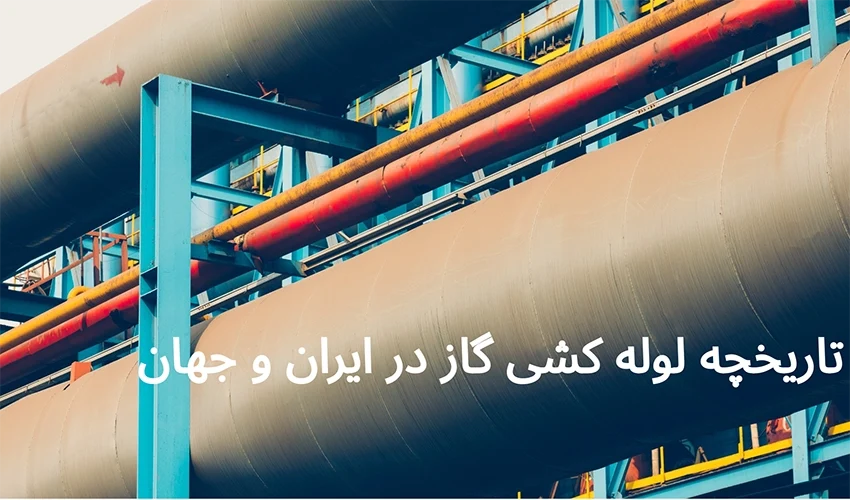The Importance of Gas Pipeline Infrastructure
Gas pipeline infrastructure is considered one of the key pillars of a country’s development. Export, economic strengthening, job creation, and enhancing social welfare are just a few of the benefits of gas pipelines. In Iran, significant investments have been made over decades to expand the gas pipeline network. Today, most areas of the country have access to gas pipelines, making gas easily available for domestic and industrial use. However, gas pipeline infrastructure has a long history, dating back to centuries before Christ.
In terms of the type of gas transported, initially, gas pipelines were used for the transmission of coal gas. Over time, however, natural gas replaced it. Nowadays, gas pipelines are primarily used to transport natural gas, while other hydrocarbon gases, such as LPG and butane, are typically transported via tankers due to their specific properties.
Pioneers of Gas Pipeline Infrastructure in the World
The history of gas shows that as early as 500 BC, the Chinese used hollow bamboo pipes to channel natural gas to the sea, where it was used to evaporate seawater and extract the required salt. Although this piping system was very simple and rudimentary, it is recognized as one of the earliest examples of gas usage in history.
The first modern gas pipeline can be attributed to Britain in the 18th century. These pipelines were made of cast iron and were used to transport coal gas. This innovation led to the lighting of London’s streets with gas lamps, which caught the attention of Naser al-Din Shah. Upon returning from Britain, he ordered the establishment of a gas lamp factory.
Initially, the pipes were made of cast iron, but in the 19th century, steel pipes of various sizes were developed. Today, pipes are made of steel or polyethylene. Polyethylene pipes have become very popular for urban and rural gas distribution lines due to their lightweight, easy installation, and resistance to corrosion. On the other hand, steel pipes are still used for high-pressure gas transmission and long-distance transportation.
The Beginning of Gas Pipeline Infrastructure in Iran
The first gas pipeline in Iran was established in the city of Masjed Soleyman. This project began in the 1950s (1330s SH) to prevent the wastage of gas from the Masjed Soleyman oil field. The extracted gas from this field was used for local domestic and industrial purposes in Masjed Soleyman. This pipeline was designed on a small and limited scale, serving only the city of Masjed Soleyman.
Subsequently, with the discovery of new gas resources in Iran, one of the major pipeline projects was the transmission of gas from the Gachsaran gas field to the newly established fertilizer production plant in Marvdasht, Shiraz. This project aimed to supply gas as a raw material for chemical fertilizer production and exemplified the expansion of natural gas usage in Iran’s industrial sector.
The First National Gas Pipeline of Iran
The First National Gas Pipeline of Iran (IGAT-1) is the country’s first natural gas transmission line, constructed in the 1960s (1340s SH) to transport gas from the southern gas fields of Iran to the northern regions and for export to the Soviet Union. This pipeline, spanning approximately 1,100 kilometers, carried gas extracted from the Aghajari gas fields and surrounding areas to domestic industrial and urban regions, as well as to the Soviet gas transmission network. This project marked a significant milestone in utilizing Iran’s natural gas resources and entering the global energy market.
In the IGAT-1 project, gas was transported from the southwestern gas fields, particularly Aghajari, to Astara to connect to the Soviet gas network. This pipeline represented a major advancement in Iran’s gas infrastructure as, in addition to the benefits of gas exports, the pipeline passed through cities like Tehran and Isfahan, enabling gas distribution to these areas.
Developments in Iran’s Gas Pipeline Infrastructure After IGAT-1
After the inauguration of the first pipeline, Iran moved toward further expansion of its gas pipeline network. With increased gas production from various fields during the 1970s and 1980s (1350s and 1360s SH), pipelines were designed and implemented to connect different regions to the national gas network. Particularly after the end of the Iran-Iraq war, gas supply was extended to remote and rural areas. Currently, Iran’s gas transmission network comprises ten national pipelines that deliver gas produced from major fields such as South Pars to various parts of the country.
Conclusion
Gas pipeline infrastructure has undergone a long and challenging journey, involving developments in gas types, pipeline materials, and more. In Iran, gas pipelines are considered one of the most successful infrastructural achievements in recent decades. They have not only provided extensive coverage to urban and industrial areas but also brought the benefits of natural gas to many rural regions.

